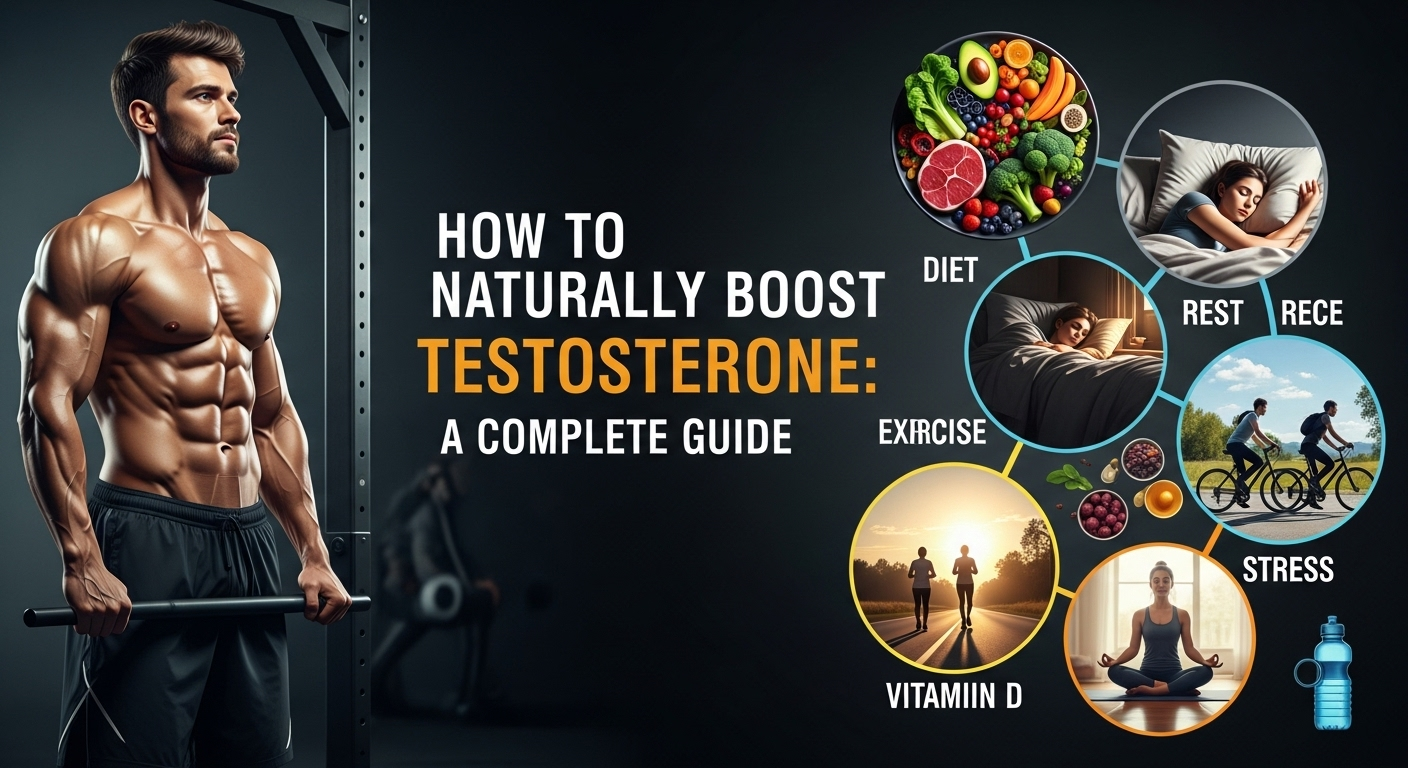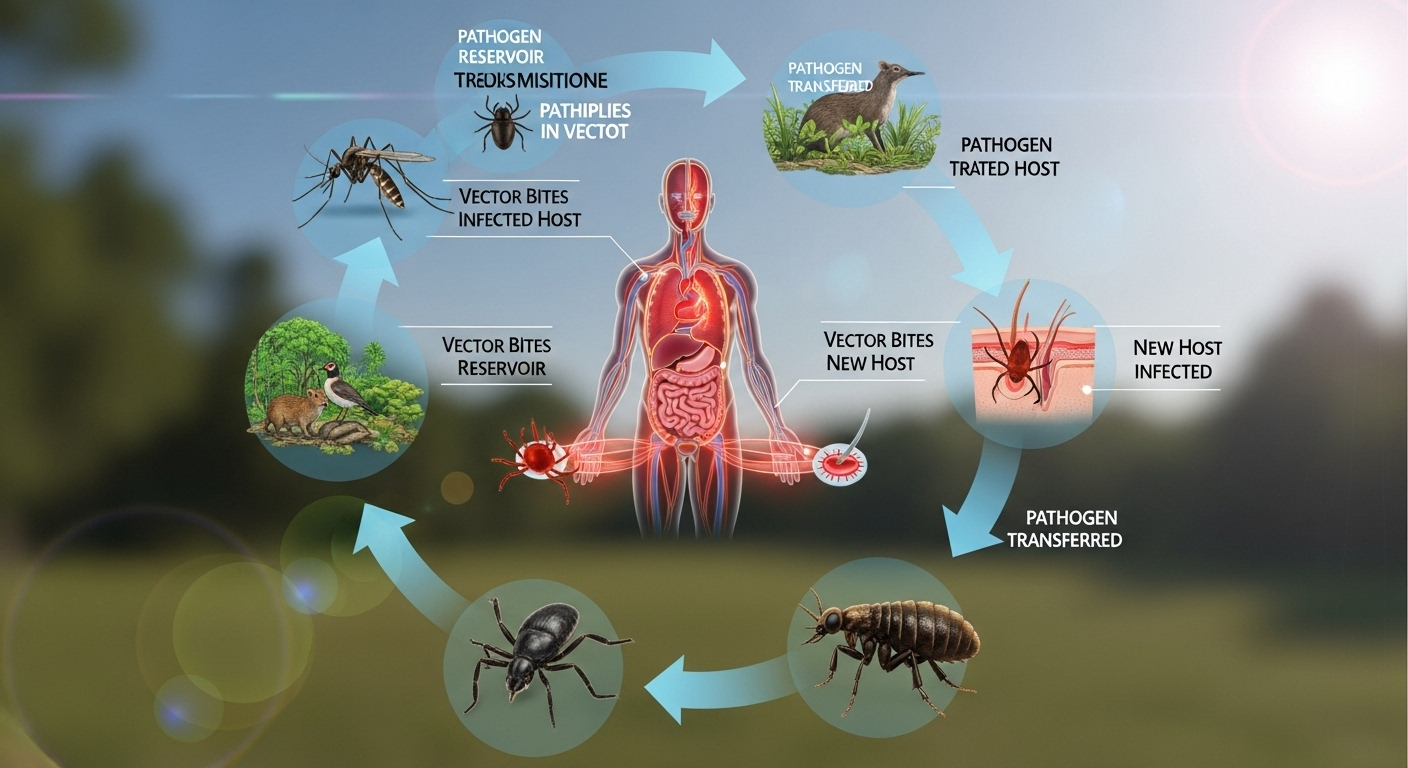Testosterone is often hailed as the quintessential male hormone, but its importance extends far beyond muscle mass and libido. It's a critical hormone for both men and women, influencing energy levels, mood, bone density, and overall vitality. As we age, a natural decline in testosterone is expected, but modern lifestyles—filled with stress, poor dietary habits, and inactivity—can accelerate this process significantly. The good news is that you don't have to resort to drastic measures immediately. If you're wondering how to naturally boost testosterone levels, you've come to the right place. This complete guide will walk you through science-backed, sustainable strategies to optimize your hormonal health from the ground up, focusing on a holistic approach that builds lasting well-being.
Table of Contents
ToggleUnderstanding Testosterone: More Than Just a "Male" Hormone
Before diving into the "how," it's crucial to understand the "what" and "why." Testosterone is the primary male sex hormone and an anabolic steroid. In men, it's produced mainly in the testes, while in women, the ovaries produce it in much smaller amounts. Its production is meticulously regulated by the brain through a system known as the hypothalamic-pituitary-gonadal (HPG) axis. The brain signals the pituitary gland, which in turn signals the testes to produce testosterone. This intricate feedback loop ensures your body has the right amount for its various functions.
This hormone is responsible for the development of male primary and secondary sexual characteristics, such as the deepening of the voice and the growth of facial hair during puberty. However, its role is far more extensive throughout life. It is vital for maintaining muscle mass and strength, promoting bone density, regulating fat distribution, producing red blood cells, and driving your libido (sex drive). Furthermore, it plays a significant role in mood regulation, cognitive function, and overall energy levels. Low levels can lead to a cascade of undesirable symptoms, making optimization a key aspect of health.
Recognizing the signs of low testosterone is the first step toward taking action. Common symptoms include chronic fatigue, reduced sex drive, difficulty achieving or maintaining erections, loss of muscle mass, increased body fat (especially around the midsection), mood swings, irritability, and even "brain fog." While these can be attributed to other conditions, a persistent combination often points toward hormonal imbalance. It's a misconception that this is only an "old man's problem"; men in their 30s and even 20s can experience clinically low testosterone due to lifestyle factors, making this guide relevant for all adult age groups.
The Cornerstone: Diet and Nutrition for Hormonal Health
Your body is a sophisticated factory, and the hormones it produces are built from the raw materials you provide through your diet. You simply cannot build optimal hormonal health on a foundation of poor nutrition. The macronutrients—protein, fats, and carbohydrates—all play a critical role. For decades, fat was demonized, leading to a surge in low-fat products. However, this was a grave mistake for hormonal health. Dietary fat, especially saturated and monounsaturated fats, is a direct precursor to steroid hormones like testosterone, as cholesterol is the foundational molecule from which they are synthesized.
A well-structured diet for hormonal optimization is not about extreme restriction but about intelligent inclusion. It means focusing on whole, unprocessed foods that are rich in the micronutrients essential for the testosterone production pathway. This involves ensuring you have adequate protein to support muscle mass (which itself supports healthy T-levels), complex carbohydrates to fuel your workouts and prevent a catabolic state, and plenty of healthy fats to provide the building blocks for hormone synthesis. Avoiding chronic, severe calorie deficits is also essential, as the body interprets starvation as a major stressor, shutting down non-essential functions like reproduction and robust hormone production.
The quality of your calories matters just as much as the quantity. A diet high in processed foods, refined sugars, and unhealthy trans fats creates a pro-inflammatory environment in the body. This systemic inflammation and associated insulin resistance are directly linked to lower testosterone levels. Therefore, the first and most impactful step you can take is to clean up your plate. Think of food not just as fuel for energy, but as information that tells your genes and hormones how to behave.
Key Nutrients That Fuel Testosterone Production
Certain vitamins and minerals act as crucial co-factors in the testosterone production process. Two of the most heavily researched and important are Zinc and Vitamin D. Zinc is an essential mineral that plays a pivotal role in modulating serum testosterone levels. Studies have shown that zinc restriction can lead to a significant drop in testosterone, while supplementation in zinc-deficient men can bring levels back to normal. Zinc is involved in the enzymatic processes within the testes and also helps in the conversion of androstenedione to testosterone. Excellent dietary sources include oysters (the most potent source), red meat, poultry, beans, and pumpkin seeds.
Vitamin D, often called the "sunshine vitamin," functions more like a steroid hormone in the body than a typical vitamin. Its receptors are found in tissues throughout the body, including the testes. Research published in the journal Hormone and Metabolic Research found that overweight men who were given Vitamin D supplements for a year saw a significant increase in their total and free testosterone levels. The most natural and effective way to get Vitamin D is through sensible sun exposure. However, for those living in northern latitudes or with darker skin, supplementation is often necessary. Fatty fish like salmon and mackerel, as well as fortified milk and cereals, are also good dietary sources.
Foods to Embrace and Foods to Limit
To build a testosterone-friendly diet, focus on incorporating a variety of nutrient-dense foods. Eggs are a hormonal superfood; the yolk is rich in cholesterol, the precursor to testosterone, as well as Vitamin D. Leafy green vegetables like spinach and kale are packed with magnesium, another mineral linked to increased free and total testosterone levels. Fatty fish like salmon and tuna are excellent for their Omega-3 fatty acids, which reduce inflammation, and their Vitamin D content. Onions and garlic, staples in many cuisines, contain a compound called allicin, which has been shown to lower cortisol and, in turn, may help testosterone production.
Conversely, some foods and substances should be limited or avoided. Excessive alcohol consumption is directly toxic to the Leydig cells in the testes where testosterone is produced, and it also increases the conversion of testosterone to estrogen. Highly processed foods and sugary drinks spike insulin levels, and chronic high insulin is linked to lower testosterone. While the debate on soy is ongoing, some studies suggest that very high intake of soy products, rich in phytoestrogens, may have a negative impact in some individuals; moderation is key. Finally, be mindful of trans fats found in many baked goods and fried foods, as they are associated with inflammation and poorer hormonal profiles.
Exercise: The Most Potent Natural T-Booster
If there is one "magic pill" for naturally boosting testosterone, exercise is the closest thing to it. Physical activity, particularly specific types, sends a powerful signal to your body to adapt, grow, and become more resilient. This adaptation process includes a robust hormonal response. Both short-term (acute) and long-term (chronic) exercise have been shown to positively influence testosterone levels. An intense workout session can cause a temporary spike in T-levels, but the more important benefit comes from consistent training over time, which can lead to a higher baseline level of the hormone.
The mechanism is multifaceted. Exercise helps control body weight, and as we will discuss later, excess body fat is detrimental to testosterone. It improves insulin sensitivity, which is favorable for hormonal health. It also stimulates the HPG axis, encouraging the brain to send stronger signals for testosterone production. The principle of "use it or lose it" applies perfectly here. An inactive, sedentary body receives signals that it doesn't need to maintain metabolically expensive tissue like muscle, and hormonal output can downshift as a result.
However, there is a critical caveat: overtraining can be just as bad, if not worse, than being sedentary. Pushing your body too hard without adequate recovery time leads to a state of chronic stress. This skyrockets the stress hormone, cortisol. Cortisol and testosterone have an inverse relationship; they operate on a seesaw. When cortisol is chronically elevated, it suppresses testosterone production. The key is to find the "sweet spot" of training hard enough to stimulate a positive response but recovering sufficiently to allow that response to take hold.
Resistance Training: Your Best Ally
When it comes to the type of exercise, resistance training (weightlifting) is king for boosting testosterone. The act of forcing your muscles to contract against a heavy load creates micro-tears in the muscle fibers. The body's repair process not only rebuilds the muscle stronger but also elicits a significant hormonal response to facilitate this growth, including an increase in testosterone and growth hormone. The most effective workouts for this purpose are those that recruit the most muscle mass.
Focus on large, compound movements that involve multiple joints and muscle groups. Exercises like squats, deadlifts, bench presses, overhead presses, and rows are far superior to isolation movements like bicep curls for eliciting a systemic hormonal response. To maximize the effect, prioritize intensity. This means lifting a weight that is challenging for you in a rep range of about 6-12 reps. Ensure you are training with sufficient volume (number of sets and reps) but also incorporating adequate rest between sets (around 60-90 seconds) to maintain intensity.
The Role of High-Intensity Interval Training (HIIT)
While resistance training is the primary tool, High-Intensity Interval Training (HIIT) is an incredibly effective supplement or alternative. HIIT involves short, all-out bursts of intense exercise followed by brief recovery periods. A classic example is sprinting for 30 seconds, followed by 60 seconds of walking or resting, repeated for several cycles. This type of training is highly demanding on the metabolic system and has been shown to produce a significant testosterone and growth hormone response.
The beauty of HIIT is its efficiency. You can get a powerful, hormone-boosting workout in just 15-20 minutes. It's an excellent way to improve cardiovascular health and insulin sensitivity without the potential for the chronic cortisol elevation that can sometimes accompany long-duration endurance cardio (like marathon running). Integrating 1-2 HIIT sessions per week alongside your resistance training can create a powerful one-two punch for optimizing your hormonal profile and overall fitness.
The Silent Killers: Managing Stress and Sleep
In our hyper-connected, fast-paced modern world, stress has become a chronic condition for many. This has a direct and devastating impact on testosterone levels due to the hormone cortisol. Cortisol is your body's primary stress hormone, released in "fight or flight" situations. In ancestral times, this was a life-saving mechanism. Today, however, deadlines, traffic, financial worries, and constant digital notifications trigger this same stress response, leading to chronically elevated cortisol levels.
As mentioned earlier, cortisol and testosterone exist in an antagonistic relationship. Cortisol is a catabolic hormone (it breaks things down), while testosterone is an anabolic hormone (it builds things up). When cortisol is high, it actively suppresses the body's ability to produce testosterone. It essentially tells your system, "We are in survival mode; this is not the time for building muscle or reproducing." Therefore, learning to manage your stress is not a "soft" skill; it is a hard requirement for healthy hormone levels.

Equally, if not more important, is sleep. Sleep is not a passive state of rest; it is an active period of intense repair, regeneration, and hormonal production. The majority of your daily testosterone release occurs during the deep stages of sleep. Studies have consistently shown a direct correlation between sleep duration and testosterone levels. One study from the Journal of the American Medical Association found that just one week of sleeping only five hours per night decreased daytime testosterone levels by 10-15% in healthy young men. This is a significant drop, equivalent to aging 10-15 years.
Practical Stress Management Techniques
You cannot eliminate all stress from your life, but you can change your response to it. One of the most effective tools is a mindfulness or meditation practice. Even 10-15 minutes of quiet breathing per day can help calm your nervous system, lower cortisol, and shift your body from a sympathetic (fight or flight) to a parasympathetic (rest and digest) state. There are numerous apps like Calm and Headspace that can guide you through this process.
Another powerful technique is spending time in nature, a practice the Japanese call shinrin-yoku or "forest bathing." Research has shown that even a short walk in a park or forest can significantly reduce cortisol levels and improve mood. Carving out time for hobbies you enjoy, engaging in social connection with friends and family, and learning to say "no" to protect your time and energy are all practical, effective ways to build resilience against chronic stress and protect your testosterone.
Optimizing Your Sleep for Hormone Production
Prioritizing sleep is non-negotiable. Aim for 7-9 hours of quality sleep per night. Consistency is just as important as duration; try to go to bed and wake up at roughly the same time every day, even on weekends. This helps regulate your body's internal clock, or circadian rhythm, which governs hormone release cycles. If you have trouble sleeping, focus on improving your "sleep hygiene."
This includes creating a sleep sanctuary: your bedroom should be cool, completely dark, and quiet. Avoid exposure to blue light from screens (phones, tablets, TVs) for at least an hour before bed, as this light tricks your brain into thinking it's still daytime, suppressing the sleep hormone melatonin. Establish a relaxing pre-sleep routine, such as reading a physical book, taking a warm bath, or listening to calming music. Avoid large meals, caffeine, and alcohol close to bedtime, as they can all disrupt sleep architecture and prevent you from reaching the deep, restorative stages where testosterone is produced.
Lifestyle Factors and Environmental Influences
Beyond the "big three" of diet, exercise, and sleep, several other lifestyle factors play a significant role in your hormonal milieu. These are the daily choices and environmental exposures that can either support or sabotage your efforts. One of the most critical is your body composition. The relationship between body fat and testosterone is a vicious cycle. Low testosterone can lead to an increase in body fat, and excess body fat—particularly visceral fat around your organs—actively lowers testosterone.
This occurs due to an enzyme called aromatase, which is abundant in fat tissue. Aromatase converts your precious testosterone into the female hormone estrogen. The more body fat you have, the more aromatase activity you have, and the more of your testosterone is being converted away. This is why achieving and maintaining a healthy body composition (typically around 10-15% body fat for men) is one of the most direct ways to increase your circulating testosterone.
Furthermore, we are constantly exposed to chemicals in our environment known as endocrine disruptors. These are substances that can interfere with the body's hormonal system. Pervasive examples include Bisphenol A (BPA) and phthalates, commonly found in plastics, food can linings, and personal care products. While avoiding them completely is nearly impossible, reducing your exposure by choosing glass or stainless steel containers, eating fresh foods, and opting for natural personal care products can help reduce your body's chemical load and support healthier hormone function.
Maintaining a Healthy Body Weight
The single most effective lifestyle intervention for many men with low testosterone is weight loss. If you are overweight or obese, reducing your body fat percentage is paramount. A study presented at the Endocrine Society's annual meeting revealed that obese men who lost weight saw a significant improvement in their testosterone levels. The goal is not to become a bodybuilder, but to reach a healthy range where aromatase activity is minimized.
The best approach to fat loss is a sustainable one that combines all the principles we have already discussed: a slight calorie deficit driven by a whole-foods diet, regular resistance training to preserve and build muscle mass, and complementary cardio like HIIT. Crash dieting is counterproductive, as it puts immense stress on the body, raises cortisol, and can lead to muscle loss, all of which are detrimental to your long-term hormonal health. Focus on gradual, steady fat loss for lasting results.
| Lifestyle Factor | Positive Impact (Promotes Testosterone) | Negative Impact (Suppresses Testosterone) |
|---|---|---|
| Sleep | 7-9 hours of quality, consistent sleep per night | Less than 6 hours per night; irregular sleep schedule |
| Diet | Whole foods, healthy fats, adequate protein, zinc, Vitamin D | High sugar, processed foods, excessive alcohol, trans fats |
| Exercise | Resistance training, compound lifts, HIIT | Sedentary lifestyle or chronic overtraining (endurance) |
| Stress | Meditation, time in nature, hobbies, social connection | Chronic work/life stress, digital overload, anxiety |
| Body Fat | Maintaining a healthy body fat % (e.g., 10-15% for men) | Being overweight or obese (increased aromatase activity) |
Frequently Asked Questions (FAQ)
Q: How quickly can I see results from making these natural changes?
A: Results vary depending on your starting point, consistency, and genetics. Some individuals may notice improvements in energy and libido within a few weeks of consistent effort, particularly with sleep and diet changes. More significant changes in body composition and blood aork, however, typically take several months. Think of this as a long-term lifestyle optimization, not a 30-day fix. Consistency is the most important factor.
Q: Are over-the-counter "testosterone-boosting" supplements effective?
A: The supplement industry is largely unregulated. Many products marketed as "T-boosters" contain proprietary blends of herbs with little to no scientific backing, or they under-dose the ingredients that do have evidence, like Zinc or Vitamin D. Your money is far better spent on high-quality food, a gym membership, and perhaps targeted supplementation of proven deficiencies like Vitamin D, Zinc, or Magnesium after consulting with a doctor. Be wary of any supplement that promises drug-like effects.
Q: Does age matter for boosting testosterone naturally?
A: Absolutely, but not in the way you might think. While a 60-year-old will likely not be able to achieve the testosterone levels of a 20-year-old, the principles for optimization remain the same. In fact, these lifestyle strategies become even more crucial with age to mitigate the natural decline. A healthy, active 50-year-old can easily have a better hormonal profile than a sedentary, overweight 30-year-old. It's never too late to start improving your hormonal health.
Q: Should I get my testosterone levels tested by a doctor?
A: If you are experiencing persistent symptoms of low testosterone, getting a blood test is a very good idea. It provides a concrete baseline and can help you and your doctor make informed decisions. Be sure to request a test for total testosterone, free testosterone, and SHBG (Sex Hormone-Binding Globulin) for a complete picture. It's best to get tested in the morning (around 8 AM) when levels are naturally at their highest.
Q: Can women also benefit from these tips for hormonal balance?
A: Yes, absolutely. While the focus is on testosterone, these principles form the foundation of overall hormonal health for both sexes. Strategies like managing stress, getting enough sleep, eating a whole-foods diet, and engaging in resistance training are universally beneficial for optimizing estrogen, progesterone, and testosterone balance in women, leading to better energy, mood, and body composition.
Conclusion
Boosting your testosterone naturally is not about finding a single secret hack or magic pill. It's about building a holistic lifestyle that creates an environment in which your body can thrive. The path to optimal hormonal health is paved with consistent, intelligent choices. It requires you to be an active participant in your own well-being by nourishing your body with nutrient-dense food, challenging it with effective exercise, prioritizing restorative sleep, and actively managing your stress.
By focusing on these four pillars—Diet, Exercise, Sleep, and Stress Management—you are not just aiming to increase a single number on a lab report. You are investing in a higher quality of life, marked by more energy, a stronger body, a clearer mind, and a greater sense of vitality. Take control of these variables, and you will give your body the tools it needs to optimize its own powerful hormonal symphony, unlocking a healthier and more vigorous version of yourself for years to come.
***
Summary of the Article
This guide provides a comprehensive, science-backed framework on how to naturally boost testosterone levels through a holistic lifestyle approach. It begins by explaining testosterone's vital role in overall health for both men and women, covering functions beyond libido and muscle, such as mood, energy, and bone density. The core of the article is built on four key pillars.
First, Diet and Nutrition, emphasizing the importance of healthy fats, adequate protein, and key micronutrients like Zinc and Vitamin D as the foundational building blocks for hormone production. Second, Exercise, highlighting resistance training with compound movements and High-Intensity Interval Training (HIIT) as the most potent physical stimuli for increasing testosterone. Third, the guide addresses the "silent killers" of Stress and Sleep, explaining the inverse relationship between the stress hormone cortisol and testosterone, and detailing how prioritizing 7-9 hours of quality sleep is non-negotiable for hormone production.
Finally, it covers other critical Lifestyle Factors, such as maintaining a healthy body composition to reduce the conversion of testosterone to estrogen and minimizing exposure to environmental endocrine disruptors. The article includes a table summarizing positive and negative lifestyle impacts, and a detailed FAQ section addressing common questions about timelines, supplements, and medical testing. The overarching message is that sustainable, long-term improvement in testosterone levels is achieved not through quick fixes, but through the consistent application of these fundamental health principles.














